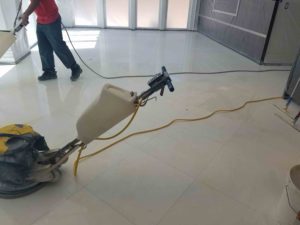
At Love Marble, we have restored hundreds of marble surfaces throughout the tri-state region over the years, including everything from marble floors in public buildings to marble countertops in some of the most exclusive private homes.
And while every job is unique, each follows the same essential five-step process: Cleaning, Grinding, Honing, Polishing, and Sealing.
Cleaning and Grinding
Before we start any marble restoration process, it’s important that the surface be as clean and free of debris, embedded dirt, and wax as possible. When marble has been maintained for many years, it can build up layers of wax and other materials — all of which must be removed first before any other steps are taken.
Grinding is then used to remove a very thin layer from the stone’s surface. The purpose is to get rid of any deep scratches, lippage, or other imperfections, essentially giving our master marble care professionals a “fresh canvas” on which to do their magic.
Honing, Polishing, and Sealing
Once the preliminaries are out of the way, the real marble restoration work can begin. Honing involves basically perfecting the surface and preparing it for the next step, which is polishing.
Our skilled technicians use specialized equipment to polish the marble surface to the point that it has the stone’s distinctive shine, whether it is a satin, semi-gloss, or high gloss finish.
Finally, the surface is sealed so that the marble is protected from water and oil-based stains for many years to come.
There also is a sixth step: Prevention. Once the marble restoration is finished, the care and maintenance of the surface need to continue. Protecting the marble against wear, staining, and scratches from heavy traffic requires almost continual attention. At Love Marble, our marble restoration process may begin with cleaning, grinding, honing, polishing, and sealing, but it goes on indefinitely with prevention.



